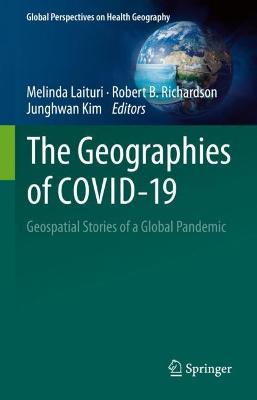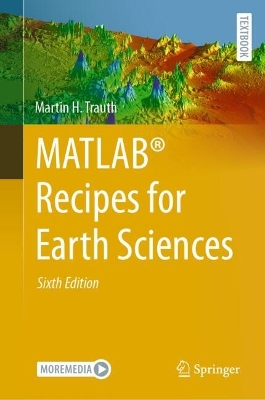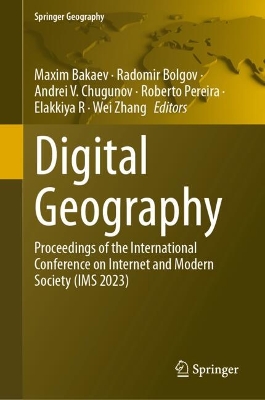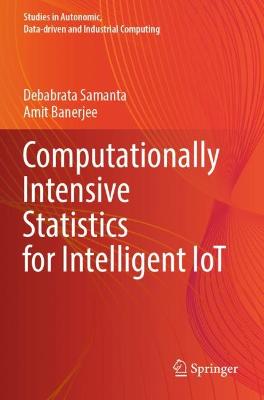Geographies of COVID-19
 portes grátis
portes grátis
Geographies of COVID-19
Geospatial Stories of a Global Pandemic
Richardson, Robert B.; Kim, Junghwan; Laituri, Melinda
Springer International Publishing AG
11/2022
300
Dura
Inglês
9783031117749
15 a 20 dias
725
Descrição não disponível.
Chapter 1. How covid changed our daily geographies.- Chapter 2. Geography of the pandemic.- Chapter 3. Defining first- and second-order impacts through maps.- Chapter 4. Quantitative geographical approaches in COVID-19 research: A review on first- and second-order impacts.- Chapter 5. COVID-19's impact on geospatial data: ethics and values.- Chapter 6. The City and the Pandemic - the Cities' COVID Mitigation Mapping (C2M2) Program .- Chapter 7. Improving access to health services in Mongolia via open data during and beyond the COVID-19 pandemic.- Chapter 8. The inequities in the U.S. during the COVID-19 pandemic.- Chapter 9. The Latine community and COVID-19: nuances, experiences, and data.- Chapter 10. An overview of the impact of COVID-19 in Nepal's international tourism industry.- Chapter 11. Data and dashboards for measuring the social impact of COVID-19 in African cities.- Chapter 12. COVID-19 and domestic violence complaints in Quito, Ecuador: temporal and spatial patterns anddrivers.- Chapter 13. Mapping COVID-19: Should it be based on the incidence rate? A case study in China.- Chapter 14. Regional patterns of the pandemic: a view from Aotearoa New Zealand.- Chapter 15. Aboriginal and Torres Strait Islander peoples & the COVID-19 pandemic: a spatial and place-based analysis.- Chapter 16. Impacts of COVID-19 pandemic lockdown on the livelihoods of male commercial Boda-Boda motorists in Uganda.- Chapter 17. Geospatial techniques for mapping the spatial trajectories of COVID-19.- Chapter 18. Digital geographies and digital surveillance technologies: power and space in the Italian society under control for public health.- Chapter 19. Resilience amid uncertainty: COVID-19 pandemic, the urban informal sector, and livelihoods in sub-Saharan Africa.- Chapter 20. Freshwater Resources and COVID-19.- Chapter 21. Preventing pandemics: earth observations for One Health.- Chapter 22. Enabling Accelerated Research in Times of Need: The National Science Foundation's Response to COVID-19 in 2020.- Chapter 23. Conclusion - The consequences of COVID-19 - What's next?.
Este título pertence ao(s) assunto(s) indicados(s). Para ver outros títulos clique no assunto desejado.
COVID-19;Health geography;Global pandemic;Inequality mapping;Geospatial data;Geovisualization;Vulnerable populations;Spatial inequity
Chapter 1. How covid changed our daily geographies.- Chapter 2. Geography of the pandemic.- Chapter 3. Defining first- and second-order impacts through maps.- Chapter 4. Quantitative geographical approaches in COVID-19 research: A review on first- and second-order impacts.- Chapter 5. COVID-19's impact on geospatial data: ethics and values.- Chapter 6. The City and the Pandemic - the Cities' COVID Mitigation Mapping (C2M2) Program .- Chapter 7. Improving access to health services in Mongolia via open data during and beyond the COVID-19 pandemic.- Chapter 8. The inequities in the U.S. during the COVID-19 pandemic.- Chapter 9. The Latine community and COVID-19: nuances, experiences, and data.- Chapter 10. An overview of the impact of COVID-19 in Nepal's international tourism industry.- Chapter 11. Data and dashboards for measuring the social impact of COVID-19 in African cities.- Chapter 12. COVID-19 and domestic violence complaints in Quito, Ecuador: temporal and spatial patterns anddrivers.- Chapter 13. Mapping COVID-19: Should it be based on the incidence rate? A case study in China.- Chapter 14. Regional patterns of the pandemic: a view from Aotearoa New Zealand.- Chapter 15. Aboriginal and Torres Strait Islander peoples & the COVID-19 pandemic: a spatial and place-based analysis.- Chapter 16. Impacts of COVID-19 pandemic lockdown on the livelihoods of male commercial Boda-Boda motorists in Uganda.- Chapter 17. Geospatial techniques for mapping the spatial trajectories of COVID-19.- Chapter 18. Digital geographies and digital surveillance technologies: power and space in the Italian society under control for public health.- Chapter 19. Resilience amid uncertainty: COVID-19 pandemic, the urban informal sector, and livelihoods in sub-Saharan Africa.- Chapter 20. Freshwater Resources and COVID-19.- Chapter 21. Preventing pandemics: earth observations for One Health.- Chapter 22. Enabling Accelerated Research in Times of Need: The National Science Foundation's Response to COVID-19 in 2020.- Chapter 23. Conclusion - The consequences of COVID-19 - What's next?.
Este título pertence ao(s) assunto(s) indicados(s). Para ver outros títulos clique no assunto desejado.







